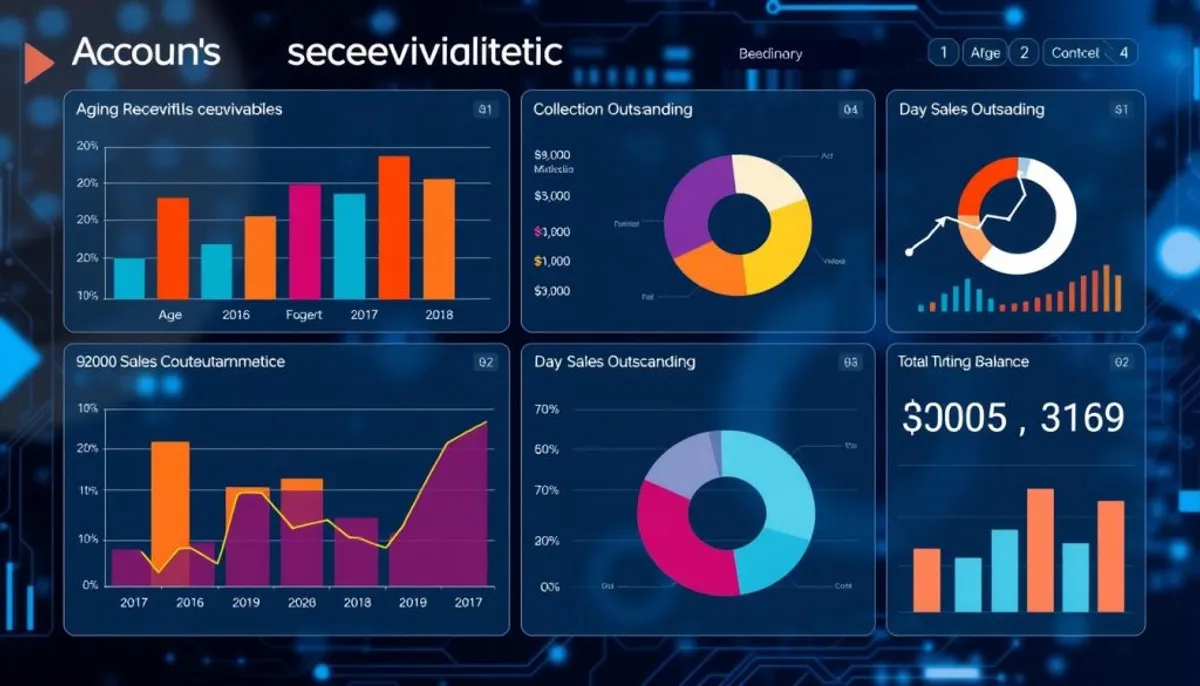Cash flow management is essential for any business’s financial well-being. Handling outstanding accounts receivable is a critical component of this. This guide aims to simplify the basics and enhance your company’s financial stability.

Managing accounts receivable transcends mere money collection. It involves nurturing customer relationships while ensuring your business’s liquidity. Effective AR management can be the linchpin between a flourishing enterprise and one teetering on the brink.
Consider these statistics. Did you know that accounts receivable automation software can reduce cash collection time by 80%? Or that AR automation boosts collection rates to 99%? These figures underscore the transformative impact of modernizing your AR processes.
Key Takeaways
- Effective AR management is crucial for business financial health
- Automation can significantly improve AR collection rates
- Clear communication and payment terms are essential
- Regular monitoring of AR metrics helps optimize cash flow
- Balancing efficient collection with positive customer relationships is key
Understanding the Fundamentals of Outstanding Accounts Receivable
For any business owner, comprehending the basics of outstanding accounts receivable is essential. This foundational knowledge is pivotal for a solid accounts receivable process. It also ensures the maintenance of a healthy cash flow.
What Are Accounts Receivable and Their Impact on Cash Flow
Accounts receivable denote the monies owed to a company for goods or services rendered on credit. They are categorized as current assets on the balance sheet, anticipated to be collected within a year. The adept management of accounts receivable has a direct bearing on a company’s liquidity and capacity to fulfill short-term obligations.
The Difference Between Accounts Receivable and Accounts Payable
Accounts receivable signify the sums customers owe to the company, whereas accounts payable denote the monies owed by the company to its suppliers. This differentiation is fundamental for grasping a company’s financial standing.
Key Components of Effective AR Management
Effective AR management entails establishing clear credit standards, implementing efficient invoice management, and developing robust collection processes. A meticulously structured accounts receivable process can notably enhance cash flow and financial stability.
| Component | Description | Impact |
|---|---|---|
| Credit Standards | Guidelines for extending credit to customers | Reduces risk of bad debts |
| Invoice Management | Timely and accurate billing | Speeds up payment collection |
| Collection Process | Systematic follow-up on overdue payments | Improves cash flow |
By concentrating on these critical components, businesses can optimize their accounts receivable process. This optimization leads to a reduction in late payments and sustains a healthy cash flow. It is crucial to remember that prompt invoice settlement and low bad debt rates are hallmarks of effective AR management.
The Critical Role of Credit Management in AR
Credit management is essential for maintaining healthy accounts receivable. It encompasses setting clear credit policies, assessing customer creditworthiness, and managing payment terms. Effective credit management optimizes cash flow and reduces financial risks.
A well-defined credit policy is the cornerstone of solid credit management. It outlines guidelines for credit extension, payment deadlines, and penalties for late payments. Such rules foster financial stability and enhance business planning.
Risk assessment is paramount in credit management. It involves evaluating the creditworthiness of both new and existing customers. Regular credit checks help minimize the risk of unpaid invoices, ensuring a healthy cash flow. Companies that prioritize thorough risk assessment often experience fewer payment delays.
Automation and technology have become crucial in credit management. Tools like automated sales order management and credit scoring systems streamline processes, enhancing efficiency. These technologies enable businesses to make informed decisions about credit extension and customer account management.
| Key Aspects of Credit Management | Benefits |
|---|---|
| Well-defined credit policy | Financial stability and better planning |
| Thorough creditworthiness assessment | Reduced risk of unpaid invoices |
| Clear payment terms | Improved cash flow and customer relationships |
| Regular credit monitoring | Early detection of potential payment issues |
Implementing effective credit management strategies significantly enhances accounts receivable performance. This results in better cash flow, reduced bad debt, and stronger customer relationships.
Essential Metrics for Tracking AR Performance
Monitoring AR performance metrics is vital for sustaining a healthy cash flow. These financial KPIs are essential for assessing a company’s efficiency in payment collection and accounts receivable management.

Days Sales Outstanding (DSO)
DSO quantifies the speed at which a company collects payments. It is calculated as: (Accounts Receivable / Total Net Credit Sales) × Number of Days in Period. A reduced DSO signifies quicker payment collection. For instance, with $45,000 in accounts receivable and $80,000 in net credit sales over a quarter, the DSO would be 51 days.
Accounts Receivable Turnover Ratio
This ratio evaluates a company’s credit management and payment collection efficiency. It is determined by dividing Net Credit Sales by Average Accounts Receivable. A higher ratio indicates superior credit management. For example, with annual credit sales of $90 million and average accounts receivable of $12 million, the ratio would be 7.5.
Collection Effectiveness Index (CEI)
CEI gauges the percentage of funds collected from customers within a specific period. An effective CEI is above 80%, with 100% being the ideal. This metric aids in pinpointing areas for collection process enhancement.
Average Days Delinquent (ADD)
ADD calculates the average time elapsed between an invoice’s due date and payment. It is computed as: (Starting Receivables + Ending Receivables) / 2. This metric is crucial for identifying clients with a history of delayed payments.
| Metric | Formula | Good Performance |
|---|---|---|
| DSO | (AR / Net Credit Sales) × Days in Period | Below 45 days |
| AR Turnover Ratio | Net Credit Sales ÷ Average AR | Higher is better |
| CEI | (Collections / (Beginning AR + Credit Sales – Ending AR)) × 100 | Above 80% |
| ADD | (Starting AR + Ending AR) / 2 | Lower is better |
By tracking these AR performance metrics, businesses can refine their cash conversion cycle and enhance their financial well-being.
Streamlining Your Billing and Collection Processes
Efficient billing procedures are essential for maintaining financial health. The adoption of electronic invoicing and payment automation can greatly enhance accounts receivable management. These technologies help in reducing late payments and improving cash flow.
Research indicates that 61% of late payments are due to cash flow problems. To address this, businesses can offer diverse payment options such as credit cards, ACH, and wire transfers. This approach makes it simpler for customers to fulfill their payment obligations on time.
Automated invoice reminders have been shown to effectively lower late payment rates. Cloud-based accounting software, which integrates these functionalities, can save time, minimize errors, and boost timely payments. Below are some key strategies for streamlining your billing processes:
- Implement standardized, automated invoicing systems
- Offer multiple payment options
- Consider early payment discounts
- Use AI-powered tools to predict payment behavior
- Set up customizable reminder schedules
It is vital to regularly monitor performance metrics such as Days Sales Outstanding (DSO) and Collection Effectiveness Index (CEI). These metrics provide insights into areas needing improvement in your billing procedures.
| Strategy | Impact |
|---|---|
| Electronic Invoicing | Reduces errors, speeds up payment process |
| Payment Automation | Improves cash flow, reduces manual work |
| Multiple Payment Options | Increases customer convenience, boosts timely payments |
| Early Payment Discounts | Incentivizes prompt payments, improves cash flow |
By embracing these strategies, businesses can optimize their billing procedures and enhance their financial health. It is important to remember that even a single past-due invoice can negatively impact cash flow. Thus, efficient accounts receivable management is critical.
Leveraging Technology for Better AR Management
In today’s fast-paced business world, managing accounts receivable (AR) efficiently is crucial. AR automation software has become a game-changer, streamlining processes and boosting cash flow. Let’s explore how technology is revolutionizing AR management.
Electronic Billing and Payment Systems
Electronic billing and payment processing systems have transformed the way businesses handle invoices. These systems speed up the billing cycle, reducing errors and improving cash flow. With automated invoicing, companies can send bills instantly and track payments in real-time.
Automated Reminder Systems
Late payments can cripple a business. Automated reminder systems tackle this issue head-on. They send timely payment reminders to customers, reducing the need for manual follow-ups. This proactive approach has led to a 13% decrease in late payments in the B2B market over the past year.
Introduction to ti3 Platform Solutions
The ti3 SaaS platform offers cutting-edge solutions for AR management. This comprehensive tool automates reminders, escalates issues, and streamlines the collection process. It’s a cost-effective alternative to traditional debt collection agencies, allowing businesses to manage overdue accounts efficiently.
By leveraging AR automation software like the ti3 platform, companies can reduce manual processes by up to 85%. This not only improves efficiency but also allows finance teams to focus on strategic tasks. The result? Better cash flow management, improved customer relationships, and sustainable growth.
Preventing and Managing Delinquent Payments
Delinquent accounts can severely impact your business’s financial health. These accounts are characterized by payments that are 30 days past due. Understanding how to prevent and manage these issues is crucial for maintaining a healthy cash flow and profitability.
Early Warning Signs of Payment Issues
Identifying potential payment problems early is essential. Monitor customers who:
- Regularly request payment extensions
- Have a history of late payments
- Display changes in their ordering habits
- Face financial challenges or leadership changes

Proactive Collection Strategies
To reduce delinquent accounts, adopt these proactive collection strategies:
- Send timely payment reminders before the due date
- Offer diverse payment options for customer convenience
- Utilize automated dunning systems for consistent follow-ups
- Provide incentives for early payments, such as a 2% discount for settling within 10 days
Handling Difficult Collection Scenarios
In challenging cases, follow these guidelines:
- Engage in professional communication
- Establish clear dispute resolution procedures
- Consider flexible payment plans
- Employ a balance of persistence and understanding in your approach
By implementing these strategies, you can effectively manage delinquent accounts and enhance your overall accounts receivable process.
Best Practices for Customer Communication
Effective communication is paramount in managing accounts receivable. A survey revealed that 90% of customers are deterred by complex buying processes, impacting their loyalty. To ensure customer satisfaction and timely payments, adopting smart communication strategies is essential.
Here are some best practices for customer communication:
- Use clear, consistent messaging about payment terms and deadlines
- Send personalized payment reminders
- Maintain a professional tone in all interactions
- Utilize various communication channels
- Tailor approaches to different customer segments
- Provide easy access to account information and payment options
Adopting these practices can significantly enhance customer satisfaction and promptness in payments. Businesses that proactively monitor failed payments experience a 37% reduction in bad debt losses compared to their counterparts.
Customer relationship management (CRM) tools are invaluable in personalizing interactions. They consider communication history, payment patterns, and customer preferences. This tailored approach often leads to faster responses and improved payment adherence.
It’s crucial to establish a routine for payment reminders and consistently follow up on overdue payments. This method is more effective than making sporadic demands. By prioritizing these communication strategies, you can optimize your accounts receivable process and maintain a healthy cash flow.
Legal and Ethical Considerations in AR Management
Managing accounts receivable necessitates a delicate equilibrium between financial aspirations and legal duties. Debt collection laws are pivotal in molding AR methodologies. These statutes safeguard consumers from unjust treatment, while enabling businesses to reclaim owed monies.
Compliance Requirements
AR managers must remain abreast of both local and global collection regulations. This entails honoring payment terms, furnishing precise debt details, and eschewing harassment. Non-compliance can incur substantial penalties and tarnish the company’s reputation.
Professional Collection Standards
Ethical debt collection transcends mere legal compliance. It encompasses treating customers with respect and honor. Professional norms encompass transparent communication, equitable negotiation, and safeguarding customer privacy. These standards not only guarantee adherence but also cultivate beneficial customer interactions.
Customer Rights Protection
Consumer protection is fundamental to ethical AR management. Customers possess the right to contest debts, demand verification, and be shielded from unfair collection tactics. AR teams must educate themselves on these entitlements and implement mechanisms to uphold them.
| Ethical Practice | Benefits |
|---|---|
| Clear communication | Reduces disputes, improves collection rates |
| Respect for customer privacy | Builds trust, ensures legal compliance |
| Fair negotiation | Increases likelihood of payment, maintains relationships |
By adhering to debt collection laws and embracing ethical practices, enterprises can proficiently manage their AR while safeguarding consumer rights. This stance not only guarantees legal adherence but also cultivates a favorable reputation and fosters enduring customer loyalty.
Conclusion
Effective AR management strategies are crucial for achieving financial efficiency and optimizing cash flow. Implementing robust practices can significantly enhance a company’s financial health. The accounts receivable turnover ratio and days sales outstanding analysis are key metrics. They help companies evaluate their collection performance.
Utilities and software development sectors often face substantial outstanding accounts receivable. For example, Incredible Software’s $100,000 payment from ABC Corporation underscores the tech sector’s need for effective receivables management. Many businesses leverage accounts receivable as collateral for loans, emphasizing its role in maintaining liquidity.
Proactive steps, such as establishing clear payment terms and using automated invoicing, can reduce unpaid receivables and improve cash flow. Regular monitoring of metrics like DSO, CEI, and average days delinquent is essential. This allows businesses to continually refine their AR processes. By prioritizing these AR management strategies, companies can improve their financial efficiency and ensure long-term success in today’s dynamic business environment.
RelatedRelated articles



